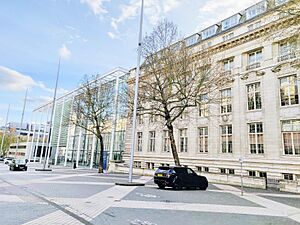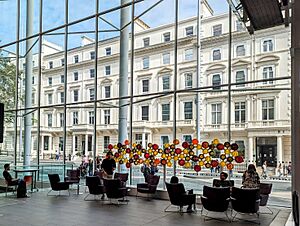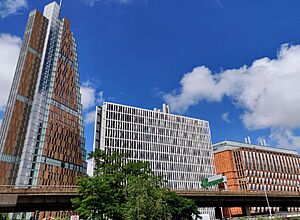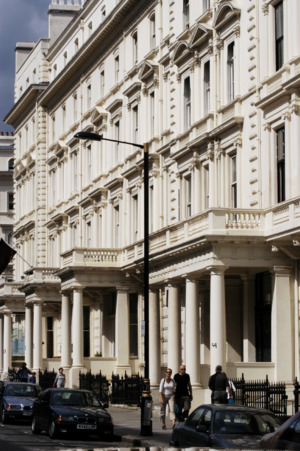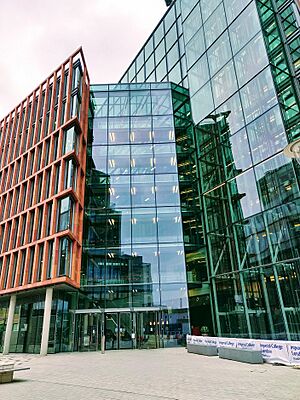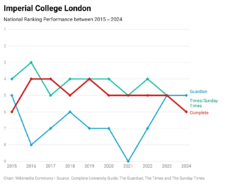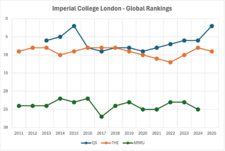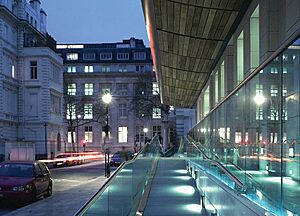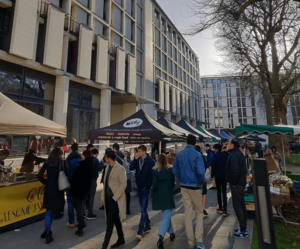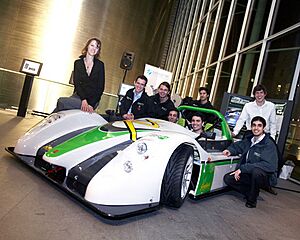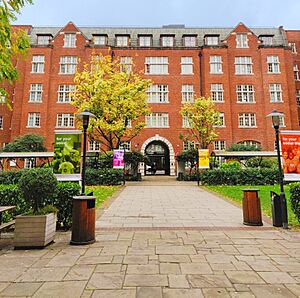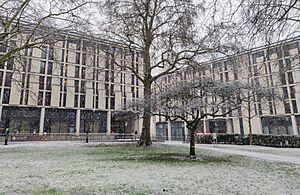Imperial College London facts for kids
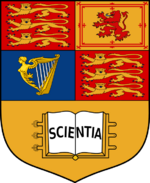
Coat of arms
|
|||||||||||||||||||||||
| Motto | Scientia, imperii decus et tutamen (Latin) | ||||||||||||||||||||||
|---|---|---|---|---|---|---|---|---|---|---|---|---|---|---|---|---|---|---|---|---|---|---|---|
|
Motto in English
|
Scientific knowledge, the crowning glory and the safeguard of the empire | ||||||||||||||||||||||
| Type | Public research university | ||||||||||||||||||||||
| Established | 1907 | ||||||||||||||||||||||
| Endowment | £235.2 million (2024) | ||||||||||||||||||||||
| Budget | £1.309 billion (2023/24) | ||||||||||||||||||||||
| President | Hugh Brady | ||||||||||||||||||||||
| Provost | Ian Walmsley | ||||||||||||||||||||||
|
Academic staff
|
4,540 (2023/24) | ||||||||||||||||||||||
|
Administrative staff
|
4,385 (2023/24) | ||||||||||||||||||||||
| Students | (2015/16) 21,265 FTE (2015/16) |
||||||||||||||||||||||
| Undergraduates | (2015/16) | ||||||||||||||||||||||
| Postgraduates | (2015/16) | ||||||||||||||||||||||
| Location | , | ||||||||||||||||||||||
| Scarf |
|
||||||||||||||||||||||
| Colours | Blue | ||||||||||||||||||||||
| Affiliations |
|
||||||||||||||||||||||
| Mascot | Lion | ||||||||||||||||||||||
Imperial College London is a famous public university in London, England. It's known for its focus on science, engineering, medicine, and business. The idea for the university started with Prince Albert, who wanted to create a special area in South Kensington for museums and colleges.
In 1907, several colleges, including the Royal College of Science and the Royal School of Mines, joined together to form Imperial College. Over the years, it grew by merging with medical schools and opening new departments like the Imperial Business School. In 2007, Imperial College became an independent university.
Today, Imperial has four main parts called faculties: Engineering, Medicine, Natural Sciences, and Business. The university encourages students to be creative and start their own projects. Its main campus is in South Kensington, with another big campus in White City. Many famous scientists and leaders have studied or taught at Imperial College.
Contents
Imperial College: A Look at Its History
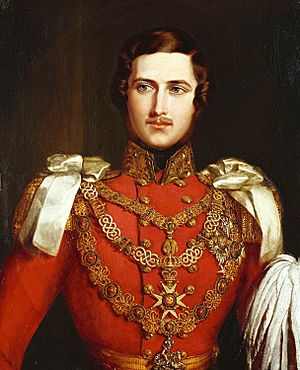
Imperial College London has a long and interesting history, starting way back in the 1800s. It grew from several smaller colleges that focused on different areas of science and medicine.
How Imperial College Began
The very first college that helped form Imperial was the Royal College of Chemistry, started in 1845. Prince Albert, the husband of Queen Victoria, supported this idea. This college later joined with others to become the Royal School of Mines.
Many medical schools across London also became part of Imperial's history. The oldest of these, Charing Cross Hospital Medical School, began teaching students in 1823.
The Great Exhibition and South Kensington
In 1851, a huge event called the Great Exhibition took place in London. It showed off amazing inventions and art from around the world. It was a big success, and the money earned from it was used to build a special area in South Kensington. This area was designed for cultural and scientific learning.
Soon after, the Victoria and Albert Museum and the Science Museum opened there. Later, the Natural History Museum also joined them. These museums are still popular places to visit today!
New Colleges and Royal Support
In 1881, the Normal School of Science was created to teach natural sciences. It was later renamed the Royal College of Science in 1890. Another important school, the Central Institution of the City and Guilds of London Institute, opened in 1884 to teach technical skills.
By the early 1900s, people in Britain worried that their country was falling behind in science education. So, in 1907, King Edward VII officially created the Imperial College of Science and Technology. This new college brought together the Royal School of Mines and the Royal College of Science. It also planned for the City and Guilds College to join later, which it did in 1910.
Growing and Changing Over Time
Imperial College joined the University of London in 1908. Students at Imperial used to have to take separate exams for University of London degrees. But in 1925, the rules changed, making it easier for Imperial students to get their degrees.
In 1945, King George VI and Queen Elizabeth visited Imperial to celebrate the 100th anniversary of the Royal College of Chemistry. This visit is remembered every October with "Commemoration Day," which is the university's main graduation ceremony.
After World War II, there was a push to make Britain's science education even stronger. Imperial College grew a lot during this time, adding many new buildings. Some older buildings were taken down to make space, but the famous Queen's Tower was saved and still stands tall today.
In the late 1980s and 1990s, Imperial merged with several medical schools, including St Mary's Hospital Medical School. This created the Imperial College School of Medicine, making Imperial a leader in medical education and research.
Imperial College in the 21st Century
In 2003, Imperial College gained the power to award its own degrees. This meant it could operate more independently. In 2007, it officially became fully independent from the University of London.
Imperial College continues to grow and innovate. In 2011, it partnered with King's College London to create the Francis Crick Institute, which is now the largest biomedical lab in Europe. The university also opened a new campus in White City in 2016, focusing on new ideas and businesses.
The university is always looking for ways to improve. In 2014, after concerns were raised about how staff performance was measured, the college reviewed its policies to make sure they were fair.
Exploring Imperial College Campuses
Imperial College London has several campuses, each with its own special purpose.
South Kensington Campus
The South Kensington campus is the main hub of Imperial College. Most of the teaching and research happens here. It's home to important buildings like the Imperial Business School, the Royal School of Mines, and the Royal College of Science.
At the heart of the campus stands the Queen's Tower, which used to be part of the Imperial Institute. This campus is in a lively area called Albertopolis, surrounded by famous London spots. You can find the Royal Albert Hall, Kensington Palace, and museums like the Natural History Museum and Science Museum nearby.
The campus has many places to eat and student housing, including Prince's Garden Halls and Beit Hall. Beit Hall is where the Imperial College Union is located, offering student pubs, a nightclub, and a cinema. Just a short walk away are Kensington Gardens and Hyde Park, which are great for relaxing and sports.
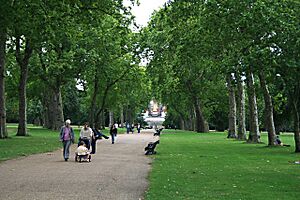
White City Campus
Imperial's newer campus in White City is a place for new ideas and starting businesses. It was built on land that used to be owned by the BBC. This campus has research facilities, housing for postgraduate students, and spaces for turning new ideas into real businesses.
It's home to the Scale Space and Invention Rooms, which is a special workshop and community center. The White City campus also has a biomedical center, which focuses on medical research.
Silwood Park Campus
Silwood Park is a campus for postgraduate students, located near Ascot in Berkshire. This campus is a key center for studying ecology, evolution, and conservation. It has 100 hectares of parkland, which is used for experiments in nature.
Teaching Hospitals
Imperial College also uses several teaching hospitals across London. These hospitals are important for the Imperial College School of Medicine to teach medical students and conduct medical research. Each hospital campus has its own college library and facilities for students.
How Imperial College is Organized
Imperial College is divided into four main parts, called faculties. These faculties then have different departments that focus on specific subjects.
Faculties and Departments
The four faculties at Imperial are:
- The Faculty of Engineering
- The Faculty of Medicine
- The Faculty of Natural Sciences
- The Imperial Business School
Each faculty has many departments. For example, the Faculty of Engineering includes departments like Aeronautics, Bioengineering, and Computing. The Faculty of Medicine has departments such as Brain Sciences and Infectious Disease. The Faculty of Natural Sciences covers Chemistry, Mathematics, and Physics. And the Imperial Business School has departments like Finance and Marketing.
Special Research Centers
Imperial College also has special centers that bring together experts from different subjects to work on big challenges. These are called Global Challenge institutes, like the Data Science Institute and the Grantham Institute for Climate Change.
The university also works with national institutes, such as the Francis Crick Institute and the Alan Turing Institute, to do important research.
Learning Beyond Science
Imperial College has centers that offer courses in subjects outside of science, technology, and medicine. The Centre for Languages, Culture and Communication offers evening classes in arts, humanities, and languages. There are also centers for Academic English and for Languages, Culture and Communication, which help students with their language and communication skills.
How the University is Run
The main governing body of Imperial College is called the Council. It has members from inside and outside the university, including the President and student representatives. The President is the top academic leader and chief executive. As of August 2022, Hugh Brady is the President.
Money and Funding
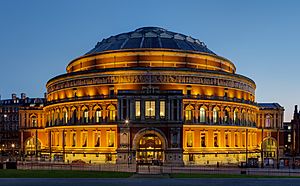
Imperial College has different ways it manages its money. It has an endowment, which is money invested to help the university in the long term. It also gets money from student tuition fees, government grants, and research grants.
In the financial year ending July 31, 2024, Imperial College had a total income of about £1.309 billion. This money helps pay for teaching, research, and running the university. Imperial has one of the largest endowments among universities in the UK.
Working with Others
Imperial College is part of many important groups and partnerships. It's a member of the Russell Group, which includes leading research universities in the UK. It also works closely with the Massachusetts Institute of Technology (MIT) in the US, sharing ideas and running exchange programs for students and staff.
Imperial is also a founding member of the Francis Crick Institute, a major biomedical research center. These partnerships help Imperial College stay at the forefront of science and technology.
Imperial College: Academic Achievements
Imperial College London is known worldwide for its excellent teaching and research.
Research at Imperial
Imperial College is a leader in research. In 2021, a review found that 66% of Imperial's research was "world class." This means their research is some of the best in the world. The university encourages its researchers to turn their discoveries into new companies and products. For example, one Imperial researcher, Narinder Singh Kapany, made important contributions to the invention of fibre optics.
Imperial works with many international partners, especially in the United States. It has a long-standing partnership with the Massachusetts Institute of Technology (MIT), which started during World War II to help with scientific efforts.
In 2018, Imperial's mathematics department teamed up with a French research center to create a special unit focused on unsolved math problems. Imperial also launched the Imperial Cancer Research UK Center, which aims to find better ways to treat cancer.
During the COVID-19 pandemic, research from Imperial College, especially a report by Neil Ferguson, was very important. It helped governments in the US and UK decide how to respond to the virus.
Getting into Imperial College
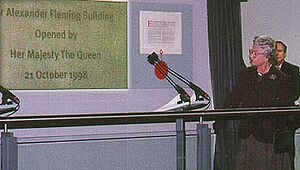
Getting into Imperial College is competitive. In the 2021/22 school year, about 9 students applied for every 1 spot in undergraduate programs. For postgraduate programs, it was about 7.7 applicants for every 1 spot.
The university offered admission to about 30.1% of its undergraduate applicants in 2022. Some of the hardest courses to get into were computing, mathematics, and mechanical engineering.
Imperial is a very international university. About half of its students come from outside the UK. In 2023/24, 40% of the students were female and 60% were male.
Libraries at Imperial
The main library at Imperial College is located next to Queen's Lawn. It holds most of the college's collection of books and resources. There are also other libraries at the hospital campuses, like the Fleming library at St Mary's.
Medicine at Imperial
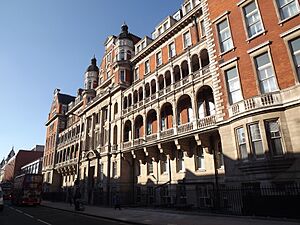
The Imperial Faculty of Medicine was formed by combining several medical schools. It works with six teaching hospitals across London. These hospitals are where medical students learn and where important medical research takes place.
Imperial College Healthcare NHS Trust manages five hospitals: Charing Cross Hospital, Queen Charlotte's and Chelsea Hospital, Hammersmith Hospital, St Mary's Hospital, and Western Eye Hospital. This trust is one of the largest in the UK and helps many patients each year.
Imperial College also has connections with many other hospitals, helping to provide medical education and care.
Reputation and Rankings
| National rankings | |
|---|---|
| Complete (2021) | 6 |
| Guardian (2021) | 5 |
| Times / Sunday Times (2021) | 6 |
| Global rankings | |
| ARWU (2020) | 25 |
| QS (2021) |
2 |
| THE (2021) | 9 |
| British Government assessment | |
| Teaching Excellence Framework | Gold |
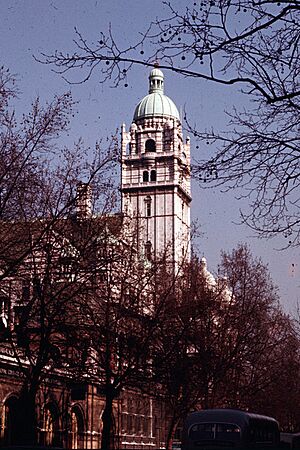
Imperial College London is considered one of the best universities in the UK and the world. In the 2026 QS World University Rankings, it was ranked 2nd globally, right after MIT. It was also ranked 9th by the Times Higher Education World University Rankings.
Imperial is known for its strong focus on business and new ideas. It has an Enterprise Lab where students can get help starting their own companies. This focus on practical skills and innovation makes Imperial graduates very sought after. In 2024, Imperial was ranked 1st in the UK for helping graduates find highly skilled jobs or continue their studies.
Student Life at Imperial College
Life at Imperial College is busy and exciting, with many opportunities for students to learn, grow, and have fun.
Student Body
In the 2023/24 academic year, Imperial College had a large student body. About 50.7% of the students came from outside the UK, making it a very diverse place. While there are more male students overall, especially in engineering, the medicine and biology programs have a more even mix of male and female students.
{{wide image|Imperial College - South Kensington Campus.jpg|600px|Queen's Lawn at the South Kensington Campus.]]
Imperial College Union
The Imperial College Union is like the student government. It's run by students who are elected for one year. The Union helps manage over 300 clubs and societies for students.
These clubs include everything from sports teams like the Imperial College Boat Club to projects that help communities in other countries, like Project Nepal. The Union has facilities at the Beit Quad in South Kensington and the Reynold's bar at Charing Cross.
Facilities for Students
Imperial College has great sports facilities, including four gyms, two swimming pools, and two sports halls. The main gym, Ethos, is at the South Kensington Campus. There are also music practice rooms for students.
Students can relax at two student bars on the South Kensington campus. The college also has a unique collection of pewter tankards, which are special mugs used by many of the student clubs.
Student Media
Imperial College has its own student media groups:
- Imperial College Radio (ICRadio) started in 1975 and now broadcasts online.
- Imperial College Television (ICTV) began in 1969 and creates TV programs for students.
- Felix is the weekly student newspaper, first published in 1949. It covers news, opinions, and reports on student events.
Student Societies
Imperial College has over 60 sports clubs, including American Football, Rugby, and Football, which compete in university leagues.
The Imperial College Dramatic Society (DramSoc) puts on plays throughout the year. Another famous group is The Techtonics, an all-male a cappella group that won an international competition in 2016.
Student Housing
Imperial College owns and manages ten student residences in London and nearby areas. Over three thousand rooms are available, and most first-year undergraduate students are guaranteed a place. These rooms come with basic furniture, shared kitchens, and internet access.
Most students live in college housing during their first year. After that, many find private accommodation, though some can stay in halls as "hall seniors." There is also housing specifically for postgraduate students at the Silwood Park campus.
Famous People from Imperial College
Imperial College has been home to many brilliant minds, including Nobel Prize winners, famous scientists, and leaders in various fields.
Nobel Prize winners include Sir Cyril Norman Hinshelwood (Chemistry), Abdus Salam (Physics), and Sir Geoffrey Wilkinson (Chemistry).
Famous academics include Sir Tom Kibble, who helped discover the Higgs Boson, and Dame Sally Davies, a former Chief Medical Officer for England. Sir John Ambrose Fleming invented the vacuum tube, and Narinder Singh Kapany invented fibre optics.
Other notable alumni include:
- Adventure and Exploration: Sir Roger Bannister, the first person to run a four-minute mile; Andreas Mogensen, the first Danish astronaut; and David Warren, who invented the flight data recorder.
- Politics: Rajiv Gandhi, a former Prime Minister of India; and Teo Chee Hean, a Senior Minister of Singapore.
- Business: Ralph Robins, former CEO of Rolls-Royce; Chew Choon Seng, former CEO of Singapore Airlines; and Brian May, the guitarist from the rock band Queen.
- Literature and Music: H. G. Wells, a famous author; and Simon Singh, an author and science journalist.
See also
 In Spanish: Imperial College London para niños
In Spanish: Imperial College London para niños
- Albertopolis
- Armorial of UK universities
- Education in London
- List of universities in the UK


